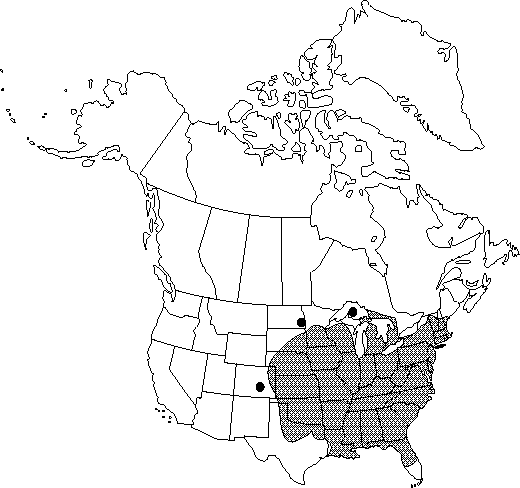Difference between revisions of "Morus alba"
Sp. Pl. 2: 986. 1753.
FNA>Volume Importer |
FNA>Volume Importer |
||
| Line 19: | Line 19: | ||
|name=Morus alba var. tatarica | |name=Morus alba var. tatarica | ||
|authority=(Linnaeus) Seringe | |authority=(Linnaeus) Seringe | ||
| + | |rank=variety | ||
}} {{Treatment/ID/Synonym | }} {{Treatment/ID/Synonym | ||
|name=Morus tatarica | |name=Morus tatarica | ||
| − | |authority= | + | |authority= |
| + | |rank=species | ||
}} | }} | ||
|hierarchy=Moraceae;Morus;Morus alba | |hierarchy=Moraceae;Morus;Morus alba | ||
| Line 49: | Line 51: | ||
-->{{#Taxon: | -->{{#Taxon: | ||
name=Morus alba | name=Morus alba | ||
| − | |||
|authority=Linnaeus | |authority=Linnaeus | ||
|rank=species | |rank=species | ||
| Line 65: | Line 66: | ||
|publication year=1753 | |publication year=1753 | ||
|special status=Weedy;Introduced | |special status=Weedy;Introduced | ||
| − | |source xml=https://jpend@bitbucket.org/aafc-mbb/fna-data-curation.git/src/ | + | |source xml=https://jpend@bitbucket.org/aafc-mbb/fna-data-curation.git/src/f50eec43f223ca0e34566be0b046453a0960e173/coarse_grained_fna_xml/V3/V3_95.xml |
|genus=Morus | |genus=Morus | ||
|species=Morus alba | |species=Morus alba | ||
Revision as of 21:32, 16 December 2019
Shrubs or trees, to 15 m. Bark brown tinged with red or yellow, thin, shallowly furrowed, with long, narrow ridges. Branchlets orange-brown or dark green with reddish cast, pubescent or occasionally glabrous; lenticels reddish brown, elliptic, prominent. Buds ovoid, 4-6 mm, apex acute to rounded; outer scales yellow-brown with dark margins, glabrous or with a few marginal trichomes; leaf scars half round, bundle scars numerous, in circle. Leaves: stipules ovate to lanceolate, 5-9 mm, pubescent; petiole 2.5-5 cm, short-pubescent. Leaf blade ovate, often deeply and irregularly lobed, (6-)8-10 × 3-6 cm, base cuneate, truncate, or cordate, margins coarsely serrate to crenate, apex acute to short-acuminate; surfaces abaxially glabrous or sparingly pubescent along major veins or in tufts in axils of principal lateral veins and midribs, adaxially glabrous to sparsely pubescent. Catkins: peduncle and axis pubescent; staminate catkins 2.5-4 cm; pistillate catkins 5-8 mm. Flowers: staminate and pistillate on same or different plants. Staminate flowers: sepals distinct, green with red tip, ca. 1.5 mm, pubescent; filaments ca. 2.7 mm. Pistillate flowers: ovary green, ovoid, slightly compressed, ca. 2 mm, glabrous; style branches divergent, red-brown, 0.5-1 mm; stigma papillose. Syncarps red when immature, becoming black, purple, or nearly white, cylindric, 1.5-2.5 × 1 cm; achenes light brown, ovoid, 2-3 mm.
Phenology: Flowering spring–summer.
Habitat: Disturbed areas, woodland margins, fencerows, dry to moist thickets
Elevation: 0-1500 m
Distribution

Ont., Ala., Ark., Colo., Conn., Del., D.C., Fla., Ga., Ill., Ind., Iowa, Kans., Ky., La., Maine, Md., Mass., Mich., Minn., Miss., Mo., Nebr., N.H., N.J., N.Y., N.C., Ohio, Okla., Pa., R.I., S.C., S.Dak., Tenn., Tex., Vt., Va., W.Va., Wis., Europe, native to e Asia.
Discussion
Morus alba is sometimes planted and possibly naturalized in Arizona, California, and New Mexico. It is reported from Washington as a local escape.
Mulberry leaves provide the natural food for silkworms. Commercially cultivated mulberries are varieties of Morus alba; they are prized as shade trees with edible fruits.
Morus alba and M. rubra are both highly variable and are often confused. Both species have deeply lobed to entire leaves and are variable in pubescence. Some individuals are intermediate in leaf pubescence, suggesting the possibility of hybridization.
Native Americans used infusions made from the bark of Morus alba medicinally in various ways: as a laxative, as a treatment for dysentary, and as a purgative (D. E. Moerman 1986.
Selected References
None.